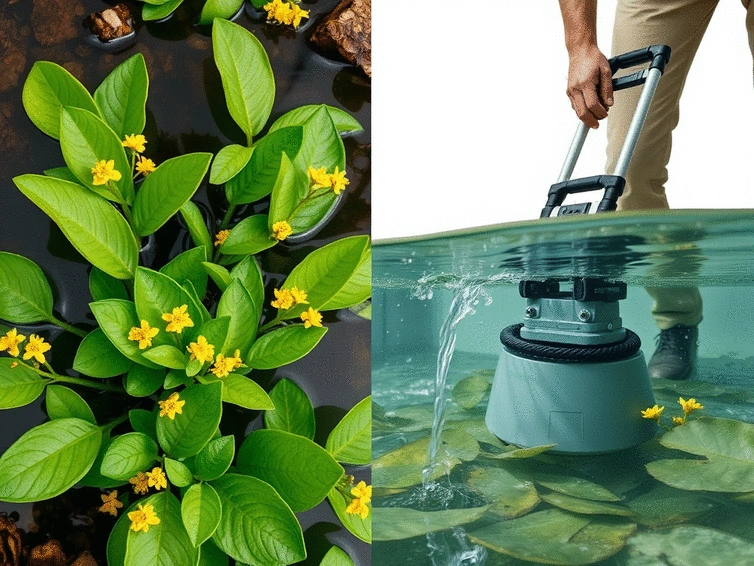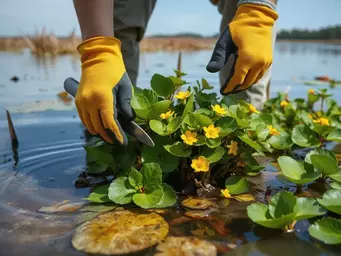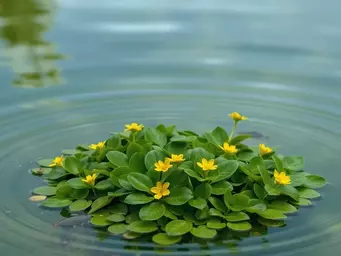Characteristics & Impact of Ludwigia peploides
- ✓ Forms dense mats, outcompeting native species.
- ✓ Reproduces via seeds & vegetative fragments.
- ✓ Alters water flow, light availability, and biodiversity.

In the intricate world of aquatic ecosystems, one plant's beauty can mask its destructive potential. As we explore the impact of Ludwigia peploides, consider how a species can both captivate and disrupt nature's balance.
Effective management of Ludwigia peploides involves a balanced approach, considering both its ecological impact and the most suitable control methods. This visual compares the characteristics and challenges associated with this invasive species, alongside key management techniques.
Mechanical Control
Chemical Control
Ludwigia peploides, or creeping water primrose, is a plant that has garnered significant attention in the realm of aquatic ecology. With its vibrant yellow flowers and sprawling growth habit, it’s easy to see why this species can captivate anyone wandering through wetlands. However, beneath its beauty lies a complex narrative of invasiveness that can dramatically alter aquatic ecosystems. Understanding its characteristics is crucial for land managers and ecologists alike. The U.S. Fish and Wildlife Service provides an ecological risk screening summary for floating primrose-willow (Ludwigia peploides), highlighting its rapid spread and ecological impacts.
This perennial herb thrives in shallow waters, often forming dense mats that outcompete native species for sunlight and nutrients. The rapid growth of Ludwigia peploides can lead to substantial ecological shifts, making it a key player in conversations about invasive aquatic plants.
Identifying Ludwigia peploides is essential for effective management. This species features distinct oval leaves that may float or be submerged, alongside striking clusters of yellow flowers. These traits not only make it visually distinct but also contribute to its ability to dominate aquatic environments.
These characteristics contribute to its classification as an invasive species, especially in regions where it disrupts local biodiversity. Have you noticed how quickly it can take over a waterway? The implications of such rapid spread are profound. For a deeper understanding of its management, the Peconic Estuary Program offers a comprehensive management plan for Ludwigia peploides.
The challenges posed by invasive aquatic weeds like Ludwigia peploides are manifold. They can lead to decreased biodiversity, disrupting local ecosystems and altering food webs. Native flora and fauna often struggle to cope with the aggressive growth of this species, resulting in a decline of native populations.
Understanding these challenges is vital for effective management strategies. As we explore solutions, we must consider not only the immediate effects of invasive species but also the long-term implications for ecosystem health.
While Ludwigia peploides is notorious for its invasive nature, it also plays a complex role in aquatic biodiversity and ecosystem services. For instance, it can provide habitat for certain species, yet its dominance may lead to a reduction in overall native diversity.
As ecologists, we must navigate these dualities, recognizing the importance of Ludwigia peploides while also advocating for management practices that foster biodiversity. How do you view the balance between its ecological role and its invasive impact? Your insights can help shape community management approaches. For more detailed insights into the challenges and strategies for managing aquatic plants like Ludwigia peploides, the Journal of Aquatic Plant Management offers valuable research.
Ludwigia peploides, also known as creeping water primrose, is an invasive aquatic plant characterized by its vibrant yellow flowers and sprawling growth habits. It thrives in shallow waters and can form dense mats.
It is considered invasive because it forms dense mats that outcompete native species for sunlight and nutrients, leading to decreased biodiversity and significant ecological shifts in aquatic ecosystems. It can also reproduce rapidly through seeds and vegetative fragments.
Its main ecological impacts include decreased biodiversity, alteration of water flow and light availability, disruption of food webs, and changes in nutrient cycling and water clarity. It can also affect predator-prey relationships.
Effective management involves a balanced approach combining mechanical controls (for quick biomass reduction, though with regrowth risk) and chemical controls (potent solutions needing careful application to avoid non-target impact). A combination of both methods tailored to site conditions is often most sustainable.
Monitoring techniques include regular surveys to track plant population changes and biodiversity, using remote sensing technologies for vegetation cover data, and involving citizen scientists in data collection to expand efforts and raise awareness.
What do you think about the balance between the ecological role of Ludwigia peploides and its invasive impact? Share your thoughts below:
Managing Ludwigia peploides, or creeping water primrose, effectively requires a thoughtful approach that balances multiple control methods. Over my years of experience as an ecologist, I've learned that understanding the strengths and weaknesses of both mechanical and chemical controls can significantly impact our efforts. Here are some key points to consider:
As we navigate these management strategies, it’s crucial to prioritize practices that minimize environmental disturbance while maximizing control effectiveness. This balance is vital to ensuring that we protect our aquatic ecosystems while addressing the challenges presented by this invasive species.
After conducting extensive research and engaging with fellow ecologists, I've compiled a list of best practices that can guide effective management of Ludwigia peploides. These practices are designed to enhance control efficacy and promote ecological sustainability:
These best practices provide a solid foundation for managing aquatic weeds effectively. They not only aim for immediate control but also emphasize the importance of long-term ecological health.
Effective monitoring is crucial for assessing the success of control strategies for Ludwigia peploides. I've found that implementing robust monitoring techniques can inform future management decisions. Here are some techniques that have proven beneficial:
By employing these monitoring techniques, we can gain valuable insights into the effectiveness of our management strategies and adapt them as necessary to ensure the ongoing health of aquatic ecosystems.
Here is a quick recap of the important points discussed in the article:
Genetic Insights in Ludwigia peploides
![Genetic Diversity and Hybridization in Ludwigia peploides: Insights from Chromosome Studies[3][4]](https://ludwigiapeploides.com/img/zpPCPoLYsB-UL_IMAGEUz4Hla-t.webp)
What if understanding the genetic diversity of a plant species could hold the key to preserving enti
Manual Removal of Water Primrose

Have you noticed creeping water primrose in local waterways? This invasive plant can significantly d
Ludwigia Peploides and Biodiversity Impact

As we grapple with the complexities of our ecosystems, understanding specific species like Ludwigia
Genetic Insights in Ludwigia peploides
Manual Removal of Water Primrose
Ludwigia Peploides and Biodiversity Impact
Ludwigia Peploides Reproduction Explained
Ludwigia peploides Control Methods Explained